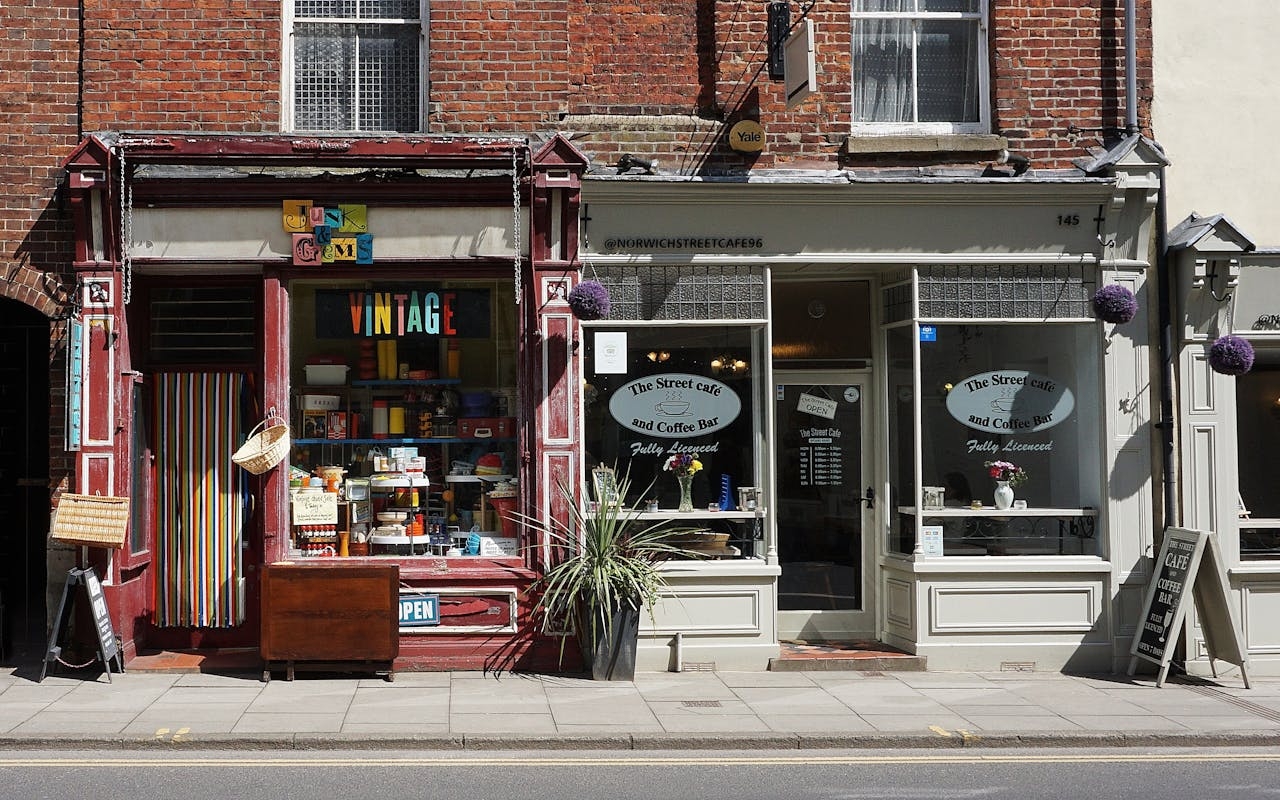Discover the Best Place to Open a Cafe: Your Guide to the Perfect Location
By Hamza Benhlima · 12. March 2024
Choosing the ideal location for a new cafe involves more than just picking a spot on the map.
It’s about diving deep into the local scene, understanding what makes it tick, and finding that sweet spot where your cafe will thrive.
Our guide is here to simplify the process, offering clear advice and practical steps to pinpoint where your cafe can become the new favourite hangout spot and the go-to place for a great cup of coffee.
So, are you ready to find the perfect place to start pouring?
Key Takeaways
- Get the lowdown on the locals: Figuring out what the nearby crowd digs lets you shape your café to hit the right note, be it with top-notch brews or the chill vibes.
- Keep tabs on the competition: Scope out the scene for other hangouts, from sweet pastry joints to quick bite delis, and make sure your café has its own cool twist.
- It’s all about the community vibe: Mix it up with the locals to get your café buzzing. Establishing connections with nearby book clubs or getting involved in the local weekend markets could turn your café into the neighbourhood’s hotspot.
Understanding Your Target Market
 cafe food + drink
cafe food + drink
Taking a step into the cafe business means getting to grips with who you’ll be serving your top-notch coffee to.
The key🗝️ to a successful cafe is really understanding your customers and choosing the best location for your cafe.
So, start digging into the local scene to get the scoop on the locals – who they are and what they like.
This goes beyond mere headcounts; it’s about crafting a vivid portrait of who will become the pillars of your cafe community, from the die-hard espresso connoisseurs to those in search of a tranquil corner to decompress, all while making sure that your cafe is situated in the best possible spot to attract a steady stream of coffee lovers.
Figuring out if your cafe will be the next hotspot for the college crowd or the preferred pit-stop for busy professionals is key.
This info shapes everything from your cafe’s vibe to the rush hours.
So, engage with potential customers, conduct surveys, and collect valuable insights that will guide you in establishing your cafe as a popular destination.
Commuting Patterns
Understanding your target customers’ commuting patterns adds another layer to your cafe location selection strategy.
Imagine a bustling office district where early morning commuters are looking for quick energy boosters or a busy train station where foot traffic guarantees a steady flow of customers.
These are prime spots and are considered the best locations for cafes and coffee shops.
By analysing when potential customers are most likely to pass by during their commutes, you can ensure your business is open when the demand for coffee is highest.
This not only helps to ensure a steady flow of customers but also informs decisions about staffing levels and stock preparation.
So, if you’re planning to ever open a coffee shop or cafe, consider these factors for success.
Coffee Consumption Habits
Keeping tabs on your target customers’ coffee consumption habits is key to running a successful café.
With changing daily routines and health and safety concerns, customers’ visit frequencies to coffee shops can fluctuate.
This requires careful consideration when setting opening hours and aligning them with new consumer patterns.
At the same time, catering to these changing habits also means having to innovate and adapt your café operations.
From implementing a strategic shift schedule to align staffing with peak hours, to expanding your breakfast and lunch menu to include quick and convenient items, there’s a lot that can be done to cater to these shifts in habits.
And remember, your café isn’t just a place to sell coffee, it’s a space that needs to adapt to the evolving needs of your customers.
Evaluating the Competition
 cafes
cafes
Now, opening a café isn’t just about understanding your customers and their habits. It also requires a keen eye on the competition.
After all, your café is not going to be the only one hoping to attract customers with the aroma of freshly brewed coffee.
Researching your competitive landscape helps in identifying opportunities and ensuring your offerings are unique enough to meet the demands of your target customers.
Evaluating the competition is a two-pronged approach.
On one hand, it’s about identifying who your competitors are, understanding their strengths, weaknesses, and how they price their products.
On the other hand, it’s about considering the proximity of established coffee shops and assessing the sensibility of opening a new café in that area.
Identifying Competitors
So, how do you identify your competitors in the coffee business? Well, it isn’t just about looking at other cafes and coffee shops.
Your competitors also include donut shops, bakeries, and sandwich shops.
Basically, any business that could potentially draw your target customers away from your café or coffee shop.
An effective competitor analysis focuses not only on competitors in your geographic location but also on market leaders or those that resemble your proposed café.
You need to understand what they offer, right from their cuisine to different styles of coffee, and how they price their products.
A handy tool to help you out here is a competitive matrix.
This can compare how your café stacks up against competitors across various factors, including:
- menu
- prices
- operation hours
- seating capacity
- traffic count
- customer service
Differentiating Your Cafe
Now that you’ve got a lay of the land and a sense of your competition, it’s time to figure out how your café is going to stand out.
This is where your Unique Selling Point (USP) comes in. Your USP could be anything – the quality of your coffee, the ambiance of your café, or your exceptional customer service.
The idea is to pinpoint those distinct traits that set your café apart from others.
The process of identifying your USP involves understanding what your competitors are doing well, addressing customer challenges, and conducting market research.
Having a well-established USP not only helps attract customers but also communicates your brand’s special qualities and sets expectations for the customer experience.
And remember, differentiation isn’t a one-time task. It’s important to routinely review and ensure your USP is effectively communicated and working for your business to maintain differentiation and a competitive advantage.
Aligning with Local Businesses
A crucial part of your café’s success story is how well it blends with the local businesses.
You should aim to be a part of a cohesive community that shares similar offerings and values.
Surrounding businesses that appeal to a similar customer base and reflect a perspective akin to your café’s products and services should be a part of your location selecting process.
Aligning with local businesses such as:
- bookstores
- newspaper stands
- pet grooming services
can create a consistent foot traffic flow and increase your café’s sales, fostering mutually beneficial relationships.
And remember, being a part of a community means your café’s offerings should complement the products and services of neighbouring businesses.
Synergy with Neighbouring Businesses
 shops
shops
Your café is more than just a place that brews coffee. It’s a community space that fosters social and communal bonds.
Being in synergy with neighbouring businesses, including else’s coffee shop, enhances your café’s food selection and creates an environment that aligns with the community’s values.
This coffee shop concept goes beyond serving beverages and focuses on building a strong local connection as an independent coffee shop, making it your own coffee shop experience.
Forming partnerships with local food establishments, such as bakeries, can provide a boost to your café’s offerings.
This not only enhances your menu but also creates a sense of communal support between your café and local goods suppliers.
Working collaboratively with neighbouring businesses increases local foot traffic, generating excitement about the area, and leading to a dedicated customer base for your café.
Collaborative Opportunities
Beyond just aligning with local businesses, there’s a whole world of collaborative opportunities to explore.
Imagine your café hosting a ‘read and refresh’ space in partnership with a local bookstore, or seasonal promotions like pumpkin spice themes during fall in partnership with local bakeries.
These initiatives not only enhance the customer experience but also generate excitement and draw in customers to both businesses.
From hosting pop-up markets for local artists or merchants to themed events like poetry nights or live music, there are numerous ways your café can foster community engagement.
These joint events or cross-promotions with local businesses can broaden your café’s customer base and contribute to a richer community experience.
Prioritising Accessibility and Inclusivity
 woman in wheelchair
woman in wheelchair
When selecting a café’s location, promoting inclusivity and fostering a warm and inviting ambiance is paramount.
After all, your café should be a place where all customers feel valued and can enjoy the offerings, irrespective of their abilities.
This means prioritising accessibility and inclusivity in your café’s design. It’s not just about making your café easily accessible for everyone, but also about creating an environment that is welcoming for everyone.
This segues into the subtopics of wheelchair access and public transportation proximity.
Wheelchair Access
Ensuring wheelchair access♿ in your café isn’t just a legal requirement; it’s a way to show that you care about all your customers.
Providing wheelchair access helps to expand your customer base and fosters a sense of community.
To ensure wheelchair accessibility, your café should have ramps at entrances, level entryways, and sufficient space between tables for easy navigation.
Providing adequate restroom facilities and reachable amenities, along with menus in large print or braille, are critical to creating an inclusive café experience.
Public Transportation Proximity
Another aspect of accessibility is the proximity to public transportation.
Your café’s location near busy public transportation hubs can attract a significant number of commuters seeking convenience, thereby expanding your customer base.
Restaurants located around busy public transportation hubs offer several advantages:
- Higher foot traffic, enhancing their visibility to potential customers
- Convenience, a key factor in encouraging repeat business from customers
- Even a small kiosk located in a train station concourse has the potential for higher profitability compared to larger, less ideally located shops.
Summary
The road to launching your dream café begins with finding that ideal spot.
It’s all about getting to know your potential customers, scoping out the competition, getting cozy with neighbouring businesses, making sure everyone can get in and feel welcome, and smartly using tech and marketing to spread the word.
You’re not just aiming to serve the best coffee☕️ but to create a thriving café business.
The best location isn’t just a dot on the map; it’s a place where people come together, where everyone feels included, and where your café’s special touch shines through.
Frequently Asked Questions
How much money do I need to open a cafe in the UK?
It can typically cost between 20.000 – 100.000€ to open a café in Europe, depending on the size, style, and location. It’s a hefty investment, but with the right planning and strategies, it can be a rewarding venture.
Is a cafe profitable in the UK?
Yes, a cafe can be profitable, but the profitability can vary based on various factors such as operational efficiency and customer attraction. Ultimately, it boils down to managing costs and attracting customers to maximise profits.
Why is understanding the target market important for selecting a café location?
Understanding the target market is crucial for selecting a café location because it ensures that potential customers will visit, leading to a steady flow of foot traffic and increased sales. So, it’s vital to know your target audience before setting up shop.
How does evaluating the competition help in running a successful café?
Evaluating the competition helps you understand their strengths and weaknesses, allowing you to adjust your strategies for a more successful café. So, keep a close eye on your rivals to brew up a winning formula!
How can alignment with local businesses benefit my café?
Aligning with local businesses can attract consistent foot traffic and foster beneficial relationships, creating a cohesive community atmosphere for your café. So, it’s a win-win!

